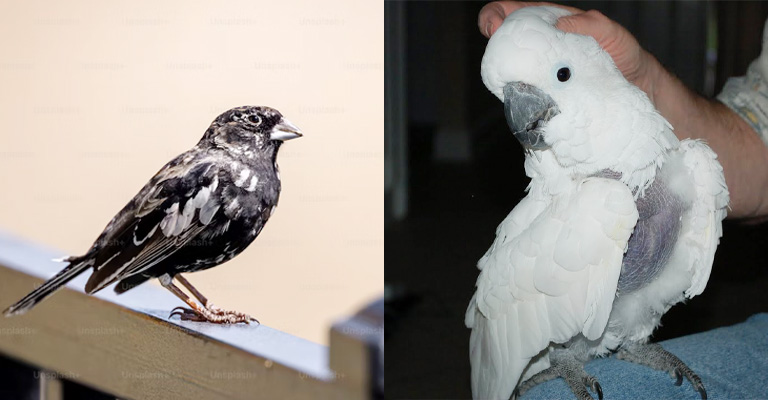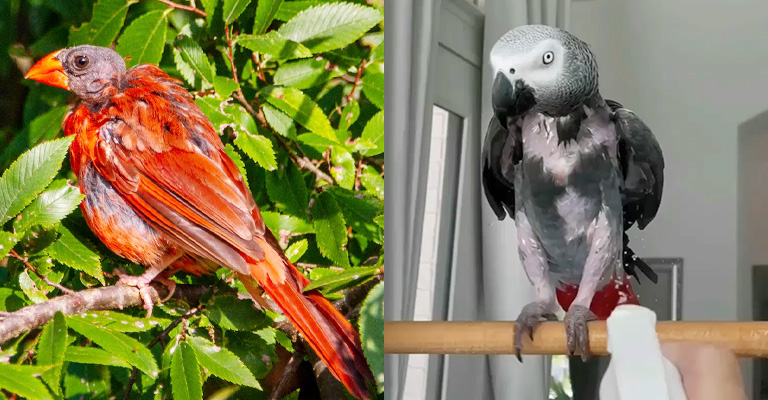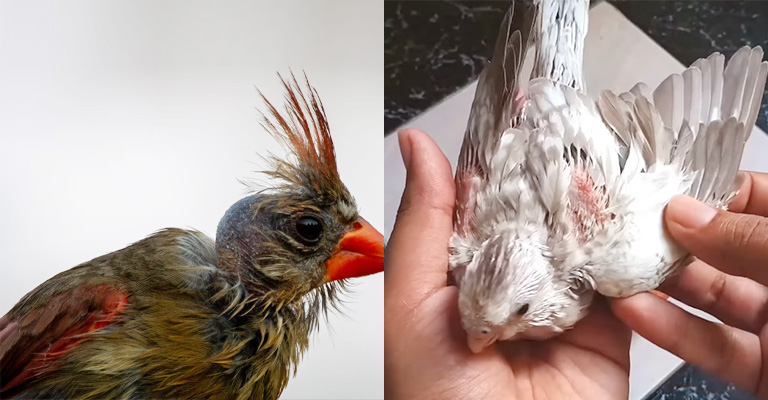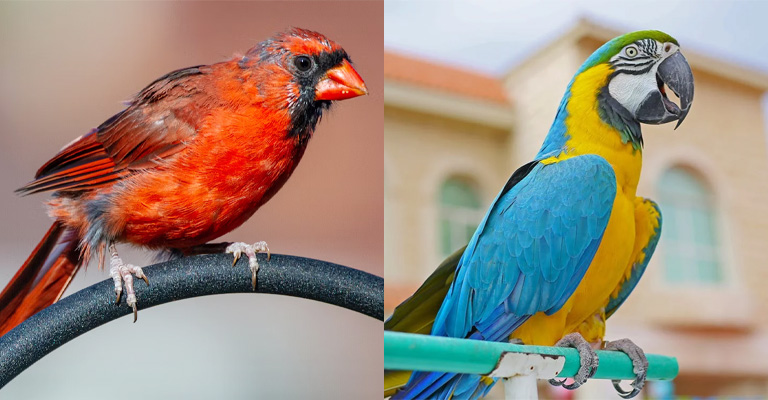Moulting and plucking stand as distinct phenomena in the fascinating world of birds, each with its unique story. Moulting represents a natural cycle of renewal, a transformational process that unveils the beauty of new feathers.
On the other hand, plucking portrays a more sombre tale, where birds engage in self-destructive behaviour that can have various underlying causes.
Join us as we embark on a journey to explore the captivating dichotomy of moulting versus plucking, shedding light on the intricacies and consequences of these feathered metamorphoses.

Difference Between Molting and Plucking
Definition
- Molting: Molting refers to the natural process in which animals, especially birds, and insects, shed their old feathers, skin, or exoskeleton to make way for new growth. It is a regular physiological process that allows animals to replace damaged or worn-out tissues with new ones.
- Plucking: Plucking is the act of forcibly pulling out feathers or hair from an animal’s body. It can be done manually by humans or through aggressive behavior by animals themselves or other animals. Plucking is not a natural process but rather an intentional or unintentional action that can result in the removal of feathers or hair from an animal’s body.
Cause
- Molting: The primary cause of molting is the need for animals to replace old, damaged, or worn-out feathers, skin, or exoskeleton. Molting is a normal part of an animal’s life cycle and is influenced by various factors such as hormonal changes, environmental conditions, and age. It allows animals to maintain the health and functionality of their outer covering.
- Plucking: Plucking can have different causes depending on the context. In some cases, animals may engage in self-plucking due to stress, boredom, or health issues. For example, birds kept in captivity may pluck their feathers out of frustration or as a response to inadequate living conditions.
Feather Appearance

- Molting: During molting, the old feathers are gradually shed and replaced with new ones. This process typically results in a gradual change in feather appearance. The new feathers grow in a coordinated manner, and there is usually a seamless transition between the old and new feathers. The overall feather appearance remains intact, although individual feathers may vary in color or pattern during the molting process.
- Plucking: Plucking can lead to a more drastic change in feather appearance. When feathers are forcibly pulled out, it can cause unevenness and disruption in the feather arrangement. This can result in an irregular and patchy feather appearance, with missing feathers in certain areas. Plucked feathers may also appear damaged or broken due to forceful removal.
Bald Spots
- Molting: During molting, animals may temporarily have areas where feathers are absent or in the process of regrowth. However, these areas are typically not extensive or persistent. Bald spots during molting are usually limited and occur as part of the natural feather renewal process. The bald areas are gradually filled in as new feathers grow.
- Plucking: Plucking can lead to more significant and persistent bald spots. When feathers are plucked out, the bald areas can be extensive and may not easily fill in. Continued plucking can result in chronic bald spots, as the regrowth of feathers may be impeded or prevented. Bald spots caused by plucking are often noticeable and can affect the animal’s appearance.
Feather Condition
- Molting: During molting, the old feathers are shed because they may be worn out, damaged, or no longer serve their intended purpose. The new feathers that grow in their place are generally in good condition. Molting allows animals to maintain healthy and functional feathers, ensuring proper insulation, flight capabilities, and protection.
- Plucking: Plucking can negatively impact feather conditions. The forceful removal of feathers can cause damage to the feather shafts, leading to frayed or broken feathers. The constant plucking of feathers can result in a decreased overall feather quality, as the regrown feathers may be weaker and more prone to damage. Plucked feathers may also exhibit signs of stress or wear, affecting their appearance and functionality.
Feather Loss Pattern

- Molting: During molting, feather loss occurs in a systematic and regulated pattern. It is a natural process in which old feathers are shed and replaced with new ones. The feather loss is typically gradual and occurs symmetrically on both sides of the body. Different species have specific molting patterns, which can be influenced by factors such as age, sex, and environmental conditions.
- Plucking: Feather loss caused by plucking does not follow a systematic pattern. It can be random and uneven, resulting in irregular patches or areas where feathers have been forcibly removed. Plucking can occur in various locations on the body, depending on the behavior or intention behind the act. The feather loss pattern due to plucking is often asymmetrical and lacks the regularity seen in molting.
Blood Feathers
- Molting: During molting, blood feathers are not typically present. Blood feathers are immature feathers that are still growing and have a blood supply running through the shaft. As the new feathers grow, the blood supply recedes, and the feathers mature. Molting involves the shedding of fully developed feathers, and therefore, blood feathers are not a characteristic feature of the molting process.
- Plucking: Plucking can result in the presence of blood feathers. When feathers are forcibly plucked, it may cause damage to the feather follicle or shaft, leading to bleeding. In some cases, the plucked feather may be in the process of growing and have a blood supply. These partially grown or damaged feathers are referred to as blood feathers. The presence of blood feathers indicates recent plucking activity.
Preening Behavior
- Molting: Preening behavior is an essential part of the molting process. Animals engage in preening to groom and maintain the health of their feathers. During molting, animals will actively preen their feathers to remove any debris, align the feather barbs, and distribute natural oils from the uropygial gland. Preening helps to ensure that the new feathers grow in a proper and functional condition.
- Plucking: Plucking behavior is distinct from preening. Plucking involves the forceful removal of feathers from the body, either by the animal itself or by external factors such as humans or other animals. Plucking is not a grooming behavior aimed at maintaining feather health but rather an action that can result from stress, aggression, or human intervention. Plucking disrupts the natural preening process and can lead to poor weather conditions.
Behavioral Signs

- Molting: During molting, animals may exhibit certain behavioral signs such as increased preening and grooming activity. They may spend more time tending to their feathers, removing old feathers, and aligning the new ones. Molting is a natural process, and animals generally show minimal signs of distress or discomfort during this time.
- Plucking: Plucking is often associated with distinct behavioral signs that indicate stress, discomfort, or abnormal behavior. Animals that engage in plucking may exhibit repetitive feather picking or pulling motions, agitation, restlessness, self-directed aggression, or vocalizations. They may display signs of frustration or anxiety, and plucking behavior is often a response to underlying issues.
Psychological Factors
- Molting: Psychological factors do not play a significant role in molting. It is a physiological process driven by hormonal changes and natural cues. Molting is not typically influenced by psychological factors such as stress, anxiety, or emotional well-being.
- Plucking: Psychological factors are often closely linked to plucking behavior. Animals may engage in plucking as a response to stress, anxiety, boredom, frustration, or underlying psychological issues. Plucking can serve as a self-soothing or coping mechanism for animals experiencing emotional or environmental challenges.
Underlying Health Issues
- Molting: Molting is a normal and healthy process that occurs in animals as part of their natural life cycle. While some underlying health issues could affect the molting process, such as nutritional deficiencies or hormonal imbalances, they are not inherent to the molting process itself.
- Plucking: Plucking can be associated with underlying health issues or medical conditions. In some cases, animals may pluck their feathers due to skin irritations, allergies, parasites, infections, or pain. Underlying health issues can contribute to the development or persistence of plucking behavior and should be addressed to effectively manage the problem.
Treatment Approach
- Molting: Molting does not typically require specific treatment unless there are underlying health issues affecting the molting process. Providing a healthy diet, appropriate environmental conditions, and ensuring access to bathing opportunities can support the molting process. Overall, molting is a natural process that animals can manage on their own.
- Plucking: Addressing plucking behavior requires a comprehensive approach. Identifying and addressing underlying psychological factors, environmental stressors, or medical conditions is crucial. Treatment may involve behavior modification techniques, environmental enrichment, stress reduction strategies, and addressing any underlying health issues.
Veterinary Consultation
- Molting: Molting generally does not require a veterinary consultation unless there are underlying health issues or concerns regarding the molting process. If an animal’s molting appears abnormal or is accompanied by other health-related symptoms, a veterinary consultation may be recommended to assess and address any underlying problems.
- Plucking: Plucking behavior often warrants a veterinary consultation. It is important to determine the underlying causes of the plucking, such as medical conditions, behavioral issues, or environmental factors. A veterinarian can conduct a thorough examination, perform diagnostic tests if necessary, and develop a treatment plan to address the underlying causes of plucking.
Duration
- Molting: The duration of molting varies among species and individuals but is generally a natural and cyclical process. Molting can last from a few weeks to several months, depending on the animal’s species, age, and environmental conditions. It is a recurring process that occurs at specific times or stages in an animal’s life.
- Plucking: The duration of plucking depends on the underlying causes and the success of treatment interventions. Plucking can be a chronic behavior that persists over a long period if the underlying issues are not addressed effectively. Treatment duration for plucking can vary significantly depending on the individual case and the response to treatment.
Feather Regrowth
- Molting: During molting, feathers are naturally shed and regrown. The regrowth of feathers during molting follows a natural pattern, and the new feathers gradually replace the old ones. Feather regrowth is a normal and self-regulated process during molting.
- Plucking: Plucking can result in the removal of feathers from the body, disrupting the natural regrowth cycle. Feather regrowth in plucked areas depends on the severity of the plucking behavior, the health of the bird, and the success of treatment. In some cases, regrowth may occur once the underlying issues are addressed, while in other cases, regrowth may be impeded or incomplete.
Impact on Bird
- Molting: Molting is a natural process that typically does not have a significant negative impact on the bird’s overall health and well-being. It is a necessary physiological process that allows the bird to replace worn-out or damaged feathers, maintaining their plumage and functionality.
- Plucking: Plucking can have detrimental effects on the bird’s physical and psychological well-being. Chronic plucking can lead to feather loss, skin damage, increased susceptibility to infections, and self-inflicted harm. It can also indicate underlying health issues, stress, or behavioral problems that may affect the bird’s overall health and quality of life.
Self-Inflicted Harm
- Molting: During molting, animals generally do not engage in self-inflicted harm. The shedding of feathers during molting is a natural and non-injurious process that does not involve self-inflicted harm.
- Plucking: Plucking behavior involves self-inflicted harm as the bird forcibly pulls out its own feathers. The act of plucking can cause physical harm to the bird’s skin and can lead to secondary issues such as wounds, infections, or increased susceptibility to external factors.
Feather Replacement
- Molting: Feather replacement during molting is a normal and natural process. As the old feathers are shed, new feathers grow in their place. The replacement feathers are typically healthy, functional, and align with the bird’s natural plumage.
- Plucking: Plucking removes feathers from the body, and the replacement feathers may be compromised due to ongoing plucking behavior. Regrown feathers may be weaker, damaged, or misaligned, resulting in an altered appearance or reduced functionality compared to the bird’s natural plumage.
Impact on Plumage
- Molting: Molting generally does not have a negative impact on the overall appearance or quality of the bird’s plumage. The natural replacement of feathers during molting ensures that the bird maintains a healthy and functional plumage.
- Plucking: Plucking can significantly impact the bird’s plumage. The removal of feathers and subsequent regrowth can result in an irregular or patchy appearance, with areas of missing or damaged feathers. The overall appearance of the bird’s plumage may be compromised, affecting its aesthetic appeal.
Treatment Success
- Molting: Treatment for molting typically focuses on addressing any underlying health issues or providing supportive care if necessary. Successful treatment outcomes for molting depend on effectively managing any underlying health concerns. However, treatment success is generally not a primary consideration for molting, as it is a natural and self-regulated process.
- Plucking: Treatment success for plucking depends on identifying and addressing the underlying causes of the behavior. It requires a comprehensive approach that may involve addressing medical conditions, behavioral interventions, environmental enrichment, and stress reduction strategies. Treatment success can vary depending on the individual case, the severity of the plucking behavior, and the bird’s response to treatment.
What Does Molting Look Like, Exactly?
To regrow new, healthy feathers, a parrot must go through moulting. Most parrots moult at least once each year, though this frequency varies by species.
Hormones and environmental factors determine when year a parrot moults. The moult cycle of wild parrots is quite regular. Therefore, they will often moult once a year around the same time. This is due to their exact circadian clock.
Domestic parrots have an inaccurate circadian rhythm because of minor exposure to natural light and limited time spent outside. As a result, these birds may initiate moulting at any time of year.
It’s also conceivable that a domestic parrot will take significantly longer to moult than its wild counterpart. This is because they will be deprived of
sunlight and must rely on artificial illumination during the day. Since most wild parrots only moult once every few weeks, a moult can take several months.
How Does It Appear?
When a parrot sheds its feathers, the corresponding feathers on the opposite side of its body will also fall off. This ensures the bird’s stability in flight.
The moulting of feathers might begin on the wings or the crown. New feathers will grow only shortly after the old ones fall out.
After the feathers fall out of your parrot, it will appear scruffy but don’t worry about it for too long. Pin feathers are the first stage of the new feathers’ development. Pins this thin and delicate are bursting with blood vessels, so handle them carefully.
These feather buds will eventually become full adult feathers, restoring your bird’s beautiful plumage. Watch the clip below to see what a bird amid moulting looks like.
What Is Feather Plucking, And What Does It Look Like?
Feather plucking is an awful thing where a parrot will pull out healthy feathers because they’re bored, want attention, need to relieve stress, and many other reasons.
The pins on parrots are different from the birds’ best features. They can appear bizarre to someone who has never seen one before. Use caution around them and give your parrot the TLC it needs while moulting so its feathers may regrow entirely and beautifully.
Parrots often resort to the terrible behaviour of plucking healthy feathers out of boredom, the need for attention, or the need to release stress.
This is a frequent problem that many pet birds have, and it’s not good for their health. Repeated plucking can cause bald spots on your bird, giving it an untidy and unhealthy appearance.
If a parrot’s follicles are damaged from repeated plucking, the bird can no longer generate feathers. Your feathered pal may get permanent bald patches as a result of this.
Because of this, it’s crucial that you put a halt to the plucking immediately rather than waiting until it’s too late.
Parrots may feel better after a round of feather plucking because it releases endorphins into the brain. As a result, some parrots may develop a mild addiction to it. They get into the habit of doing it and can’t break it.
How does it appear?
When a parrot is plucking, it typically keeps its beak in its feathers for extended periods. While this may appear harmless preening at first glance, a closer inspection may reveal that your bird is tugging at a specific location.
When parrots aren’t moulting, their feathers get somewhat stuck, requiring strong pulling to remove. The parrot may squeal in agony as it plucks the feather out of its skin.
When a parrot plucks, bald spots or areas with few feathers become apparent. Keep a close eye on their chest and wings, as the plucking is most likely to begin here.
This parrot has had practically all of the frontal body and wing feathers removed. The down feathers, which look like fluff, are a sublayer beneath the parrot’s outer feathers.
What Does Plucking Look Like, and Why Does Your Conure Pick at Its Feathers?
Your conure’s feather plucking could be due to a variety of issues. It could be a mental issue, or it could be a physical one. Look over this list and see if anything catches your eye
it may be caused by-
- Frustration – Lack of Interest.
- Lack of care or focus; neglect.
- More playtime and attention contribute to inactivity.
- Lack of Exercise and Time Outside the Cage.
- Inability to get enough shut-eye because of external factors such as noise or light.
- Poor Nutritional Habits or Poor Diet
- Altering One’s Surroundings by Moving, Acquiring a Pet, etc.
- Skin dry and irritated due to low humidity, central heating, or air conditioning.
- Illness or general pain and discomfort
- Symptoms of Allergies: A General Aching Feeling
- Hormonal Shifts – The mating season can cause behavioral changes.
- Wound infection causes skin inflammation.
- Discomfort/Pain Due to Parasite Infection
Molting Vs Plucking: comparison table
Here are some comparison facts about molting vs plucking-
| Difference | Molting | Plucking |
| Definition | This may indicate stress or underlying health concerns | Abnormal behavior of self-feather removal |
| Cause | Seasonal changes, hormonal shifts | Behavioral, medical, or environmental issues |
| Feather appearance | Feathers shed gradually and evenly | The natural process of feather renewal |
| Bald spots | No bald spots | Bald spots may be present |
| Feather condition | Feathers look healthy and intact | Feathers may be frayed or broken |
| Feather loss pattern | Generally symmetrical shedding | Feathers may be plucked in specific areas |
| Blood feathers | No interference with blood feathers | Blood feathers may be plucked or damaged |
| Preening behavior | Regular preening of healthy feathers | Excessive or aggressive preening |
| Behavioral signs | Normal activity levels | Restlessness, anxiety, or aggression |
| Psychological factors | None | Stress, boredom, or anxiety |
| Underlying health issues | Typically no underlying health issues | Underlying health issues should be addressed |
| Treatment approach | No treatment is required, the natural process | Requires behavior modification and addressing underlying causes |
| Veterinary consultation | Generally not needed unless other health concerns | Essential for accurate diagnosis and treatment guidance |
| Duration | Can last several weeks to months | May persist for extended periods of time |
| Feather regrowth | Feathers regrow normally | Feathers may not regrow or regrow abnormally |
| Impact on bird | Generally does not affect overall well-being | May indicate stress or underlying health concerns |
| Self-inflicted harm | No self-inflicted harm | No treatment is needed, natural process |
| Feather replacement | New feathers replace old feathers | Feathers may not be replaced properly |
| Impact on plumage | Plumage remains intact and healthy | Plumage may appear sparse or damaged |
| Treatment success | No treatment is needed, the natural process | Success depends on addressing underlying causes and modifying behavior |
FAQ
Molting is a natural process in birds where they shed old, damaged feathers and replace them with new ones. It allows birds to maintain the health and functionality of their plumage.
Molting itself is not painful for birds. However, during molting, birds may experience itching or discomfort as new feathers grow, which can lead to increased preening and grooming behavior.
Plucking, also known as feather picking or self-mutilation, refers to a bird pulling out its feathers. It can be a behavioral disorder with various underlying causes, including stress, boredom, illness, or environmental factors.
Treatment and prevention of plucking depend on identifying and addressing the underlying cause. It often involves veterinary examination, behavior modification, environmental enrichment, and addressing any medical conditions.
Yes, molting and plucking can be distinguished. Molting occurs in a predictable pattern, usually affecting multiple feathers simultaneously, while plucking results in more irregular feather loss, often leaving bald patches or damaged feathers.
For birds going through molting, providing a balanced diet, maintaining a clean and stress-free environment, and offering opportunities for preening can support healthy feather growth. Consulting a veterinarian or avian behavior specialist is crucial for birds with plucking issues to identify and address the underlying causes and provide appropriate care.
Plucking can sometimes be reversible with proper diagnosis, treatment, and management of the underlying causes. However, it may require time, patience, and a comprehensive approach involving both medical and behavioral interventions.
When occurring as part of a natural cycle, moulting does not usually affect a bird’s overall health negatively. However, plucking can lead to physical complications, such as skin infections or injury, and can indicate underlying health or behavioral issues that must be addressed promptly.
Conclusion
As we bid farewell to our exploration of molting and plucking, we are left with a profound appreciation for the intricacies of nature and the emotional complexities of our avian friends.
Molting is a testament to resilience and growth, an enchanting dance of feathers that signals transformation and rebirth. Meanwhile, plucking, a sorrowful act born from a myriad of potential causes, reminds us of the delicate balance between physical and emotional well-being.
May our understanding of these processes foster empathy and inspire efforts to provide a nurturing environment where birds can thrive, ensuring that the beauty of molting outweighs the darkness of plucking.